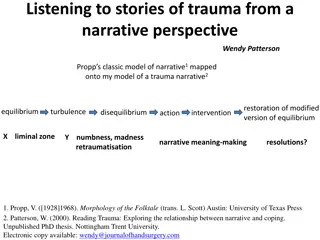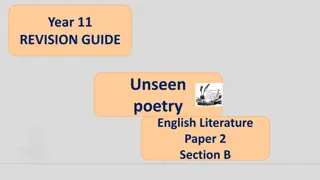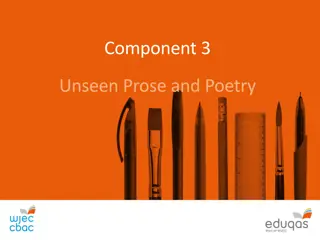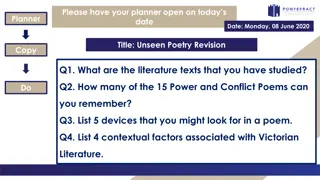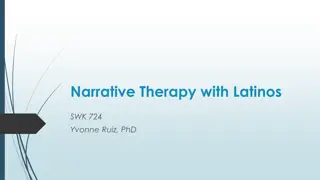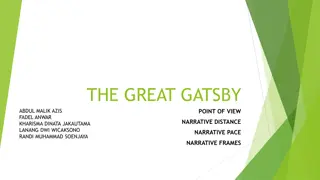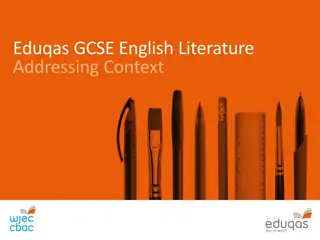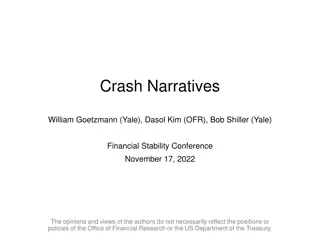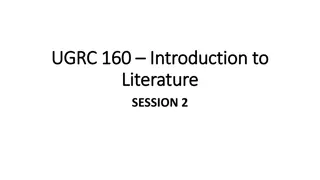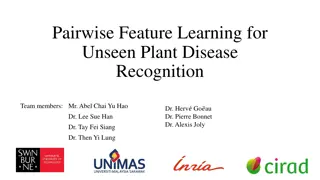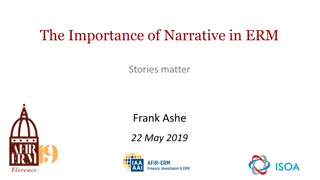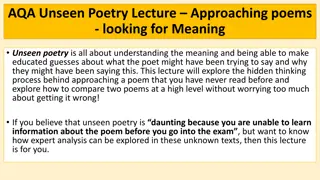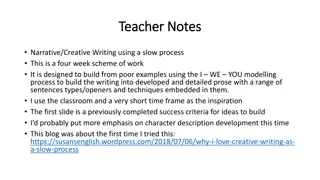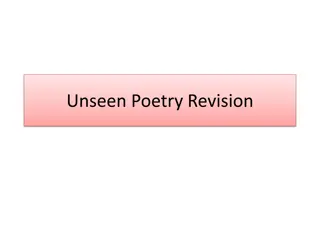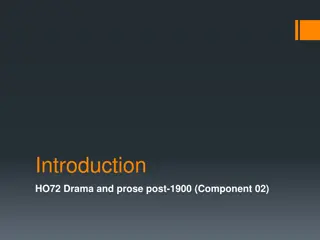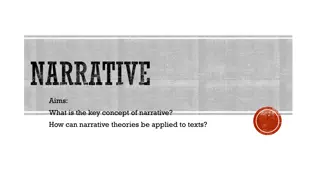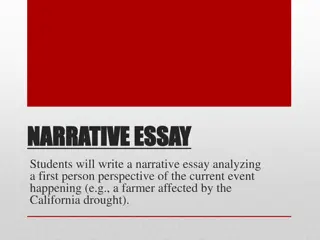Understanding Narrative Perspective in Unseen Prose Narratives
Explore the narrative voice in unseen prose narratives through the analysis of different narrative perspectives, such as homodiegetic and heterodiegetic narrators. Understanding these terms helps in interpreting the impact of perspective on storytelling and themes in literary texts for exam preparation and coursework.
Download Presentation

Please find below an Image/Link to download the presentation.
The content on the website is provided AS IS for your information and personal use only. It may not be sold, licensed, or shared on other websites without obtaining consent from the author. Download presentation by click this link. If you encounter any issues during the download, it is possible that the publisher has removed the file from their server.
E N D
Presentation Transcript
ANALYSING UNSEEN PROSE NARRATIVE VOICE
FROM THE FIFTH SEASON (2016) N.K. JEMISIN STARTER You are she. She is you. You are Essun. Remember? The woman whose son is dead. You re an orogene who s been living in the little nothing town of Tirimo for ten years. Only three people here know what you are, and two of them you gave birth to. Well. One left who knows, now. For the past ten years you ve lived as ordinary a life as possible. You came to Tirimo from elsewhere; the townsfolk don t really care where or why. Since you were obviously well-educated, you became a teacher at the local cr che for children aged ten to thirteen. You re neither the best teacher nor the worst; the children forget you when they move on, but they learn. You re the mother of two children, but now one of them is dead and the other is missing. Maybe she s dead too. You discover all of this when you come home from work one day. House empty, too quiet, tiny little boy all bloody and bruised on the den floor. And you shut down. You don t mean to. It s just a bit much, isn t it? Too much. You ve been through a lot, you re very strong, but there are limits to what even you can bear. Read this extract: do you notice anything unusual about the narrative voice?
When you first read an unseen prose text, its a good idea to step back from the text to consider what the writer is doing in terms of big ideas and techniques. UNSEEN PROSE One of the first things to consider in terms of techniques is narrative perspective or voice. STEPPING BACK FROM A TEXT In this lesson we will ask: What do we mean by narrative perspective? What different perspectives is it possible for a writer to write from? What key words are going to be worth using when we talk about it?
NARRATIVE TERMS Homodiegetic narrator: a homodiegetic narrator - also known as first person narration - participates as a character in the story. Philip Roth s American Pastoral in the Unseen Prose booklet is an example of this Heterodiegetic narrator: a heterodiegetic narrator, in contrast, describes the experiences of the characters that appear in the story in which he or she does not participate. Broadly speaking this is also known as third person narration, although it can occasionally be second person (you), as seen in the previous slide. Cormac McCarthy s Blood Meridian in the Unseen Prose booklet is an example of this These terms are useful but not essential. Identifying which type of narration a writer has selected and analysing its effects are what matter most. Task In one-two sentences: compare the opening paragraphs of these two texts and explain what effect this first/third person perspective has on the story. Try writing one or two lines using the opposite for each what difference does this make to the text? You do not necessarily need to use all of these terms. But understanding them - and why a writer may choose to use them - will help you to understand how a text works and the kind of themes and meanings it is asking us to consider. This presentation refers to the Unseen Prose booklet: we will use this throughout the course to prepare for an unseen prose question in the A Level exam at the end of year two, and a source for potential coursework texts.
MORE NARRATIVE TERMS CHOICE ONE: HOW MUCH DO THEY KNOW? Limited narrator: there are things that the narrative voice does not know. The story sticks pretty closely to a single character's viewpoint, and the narrative voice only ever tells us about that character's thoughts and feelings - no peeking into the heads of anyone else. This is likely also to be subjective. (Unseen Prose booklet example: Vladimir Nabokov s Lolita.) It simportant to consider what type of narrator we have. Omniscient narrator: The omniscient narrative voice is totally in charge of the story: like a film director, pointing you towards images and people as it sees fit, acting in the same way as a camera. The omniscient narrator feeds us information about characters and plot in a structured, orderly way to maximise atmosphere, tension and suspense. This can sometimes lead to intrusive narration if there are judgements offered in the narration. (Unseen Prose booklet example : Arundhati Roy s God of Small Things.) This can sometimes be difficult to assess in a short extract, so it is important use all the information you are given.
MORE NARRATIVE TERMS CHOICE TWO: WHOSE POINT OF VIEW? Subjective narrator: When a story is told through a specific person's point of view, that story is said to have a subjective narrator.This first-person narrative style means that readers are seeing a story through a specific person's eyes. This is likely also to be limited. (Unseen Prose booklet example: Anthony Burgess s A Clockwork Orange.) It simportant to consider what type of narrator we have. Objective narrator: a third person objective narrator is just a witness to a story. They don't have knowledge of any of the character's thoughts or feelings (so are likely to be limited rather than omniscient) but are simply reporting on what is happening. They let the audience form their own opinions based on objective observation. (Unseen Prose booklet examples: Cormac McCarthy s Blood Meridian and Truman Capote s In Cold Blood.) This can sometimes be difficult to assess in a short extract, so it is important use all the information you are given.
EVEN MORE USEFUL NARRATIVE PERSPECTIVE TERMS Unreliable narrator TASK For each of terms on the left: Second person narration explain what it means. Stream-of- consciousness find an example in the texts in this presentation, or any books you ve read. think about why a writer might choose to use? Present tense Again do not worry too much about remembering all of the terms: why it might be used to tell the story is the main thing to try to comment on. Examiners are more interested in your explanations and analysis than your terminology. Past tense Free indirect discourse
Were going to look at some very short extracts and establish: Which of the key words we have looked at help you to describe and define the narrative perspective? More importantly, how does the writer s choice of this narrative perspective specifically contribute to our understanding of what s going on and the text s possible themes and meanings? USING NARRATIVE TERMS Does the narrative perspective help create specific ideas about atmosphere, mood, tone or characterisation? QUICK ANALYSIS A good way to help you think about these questions is to briefly consider how meaning would alter if a different narrative perspective were used for that text. You might also want to think about if there any other key methods in these extracts that help with you understanding.
WHERE ITS ALL HEADING: THE UNSEEN PROSE EXAM QUESTION Here s what the exam question will look like: The theme will be from a list of modern times themes such as gender, family, identity or isolation. Narrative perspective is one of the first ways you would analyse in your answer.
For each extract, think and make notes about how you would write about narrative voice in answer to the question below: Explore the significance of [theme] in this extract. Remember to include in your answer relevant detailed analysis of the ways that [author s name] shapes meanings. The theme for each extract is indicated at the top of each slide. When you ve looked at them all, choose your favourite and write a paragraph. This should take you about 15 minutes. You will find some advice on writing a successful paragraph at the end of this presentation.
FROM THE FIFTH SEASON (2016) N.K. JEMISIN Theme: Isolation You are she. She is you. You are Essun. Remember? The woman whose son is dead. You re an orogene who s been living in the little nothing town of Tirimo for ten years. Only three people here know what you are, and two of them you gave birth to. Well. One left who knows, now. For the past ten years you ve lived as ordinary a life as possible. You came to Tirimo from elsewhere; the townsfolk don t really care where or why. Since you were obviously well-educated, you became a teacher at the local cr che for children aged ten to thirteen. You re neither the best teacher nor the worst; the children forget you when they move on, but they learn. You re the mother of two children, but now one of them is dead and the other is missing. Maybe she s dead too. You discover all of this when you come home from work one day. House empty, too quiet, tiny little boy all bloody and bruised on the den floor. And you shut down. You don t mean to. It s just a bit much, isn t it? Too much. You ve been through a lot, you re very strong, but there are limits to what even you can bear. How would you describe the narrative perspective here? What effect does it have on the narrative? How does the narrative voice contribute? Narrative voice = the language and style of the narrator, together with the things the narrator chooses to focus on
Theme: Alienation FROM MINARET (2005) LEILA ABOULELA The elevator is the old-fashioned type so that I have to yank the door. It clatters in the elegant quiet of the building. I reach to press the button for the second floor but find that the first button says one to three, the second three to four, and the third four to six. I try to work it out, stare at it but I am still confused. I decide to climb the stairs instead. A door slams above me; quick footsteps descend the stairs. When he comes within sight I see a youth who is tall and gangly with the start of a beard and curly hair. I stop him and ask about the elevator. It s the flat numbers, not the numbers of the floor. He speaks English as if it is his mother tongue but the accent is not local. It is difficult guessing people s origins in London. If he were Sudanese, he would be considered light-skinned but I have no proof that he is. QUESTIONS TO THINK ABOUT Why is there so much detail about the lift? What do you make of the youth and the way he is presented? What questions does the narrative raise? Right, thanks. I smile but he does not smile back. How would you describe the narrative perspective here? What effect does it have on the narrative? How does the narrative voice contribute?
Theme: Self-doubt FROM PLAY IT AS IT LAYS (1970) JOAN DIDION She looked at Carter sitting in the living room and all she could think was that he had put on weight. The blue work shirt he was wearing pulled at the buttons. She supposed that he had weighed that much when he left, she noticed it now only because she had not seen him. You going to stay here? she said. He rubbed his knuckles across the stubble on his chin. All my things are here, aren t they? Maria sat down across from him. She wished she had a cigarette but there were none on the table and it seemed frivolous to go get one. Carter s saying that all his things were in the house did not seem entirely conclusive, did not address itself to the question. Quite often with Carter she felt like Ingrid Bergman in Gaslight, another frivolous thought. How would you describe the narrative perspective here? QUESTIONS TO THINK ABOUT How would you describe Maria s attitude to Carter? What is the significance of Carter s question? What effect does it have on the narrative? How does the narrative voice contribute?
Theme: Judgement FROM THE GOLDFINCH (2013) DONNA TARTT She'd seen me, too. We'd been eyeing each other as we were going through the galleries. I wasn't quite even sure what was so interesting about her, since she was younger than me and a little strange-looking nothing at all like the girls I usually got crushes on, cool serious beauties who cast disdainful looks around the hallway and went out with big guys. This girl had bright red hair; her movements were swift, her face sharp and mischievous and strange, and her eyes were an odd color, a golden honeybee brown. And though she was too thin, all elbows, and in a way almost plain, yet there was something about her too that made my stomach go watery. She was swinging and knocking a battered-looking flute case around with her a city kid? On her way to a music lesson? Maybe not, I thought, circling behind her as I followed my mother into the next gallery; her clothes were a little too bland and suburban; she was probably a tourist. But she moved with more assurance than most of the girls I knew; and the sly, composed glance that she slid over me as she brushed past drove me crazy. How would you describe the narrative perspective here? QUESTIONS TO THINK ABOUT What do you learn about the narrator? What effect does it have on the narrative? How does the narrative voice contribute?
Theme: Perception FROM THE ACCIDENTAL (2005) ALI SMITH The beginning of things when is it exactly? Astrid Smart wants to know. (Astrid Smart. Astrid Berenski. Astrid Smart. Astrid Berenski.) 5.04 a.m. on the substandard clock radio. Because why do people always say the day starts now? Really it starts in the middle of the night at a fraction of a second past midnight. But it s not supposed to have begun until the dawn, really the dark is still last night and it isn t morning till the light, though actually it was morning as soon as it was even a fraction of a second past twelve i.e. that experiment where you divide something down and down like the distance between the ground and a ball that s been bounced on it so that it can be proved, Magnus says, that the ball never actually touches the ground. Which is junk because of course it touches the ground, otherwise how would it bounce, it wouldn t have anything to bounce off, but it can actually be proved by science that it doesn t. How would you describe the narrative perspective here? What effect does it have on the narrative? How does the narrative voice contribute?
Theme: Escape FROM THE BLOODY CHAMBER (1979) ANGELA CARTER I remember how, that night, I lay awake in the wagon-lit in a tender, delicious ecstasy of excitement, my burning cheek pressed against the impeccable linen of the pillow and the pounding of my heart mimicking that of the great pistons ceaselessly thrusting the train that bore me through the night, away from Paris, away from girlhood, away from the white, enclosed quietude of my mother s apartment, into the unguessable country of marriage. And I remember I tenderly imagined how, at this very moment, my mother would be moving slowly about the narrow bedroom I had left behind forever, folding up and putting away all my little relics, the tumbled garments I would not need any more, the scores for which there had been no room in my trunks, the concern programmes I d abandoned; she would linger over this torn ribbon and that faded photograph with all the half-joyous, half-sorrowful emotions of a woman on her daughter s wedding-day. And, in the midst of my bridal triumph, I felt a pang of loss as if, when he put the gold band on my finger, I had, in some way, ceased to be her child in becoming his wife. How would you describe the narrative perspective here? HINTS Symbolism Switch in focus from narrative present to the mother What effect does it have on the narrative? How does the narrative voice contribute?
TO WRITE A SUCCESSFUL PARAGRAPH, YOU NEED To focus on question / key words from the question (including the theme words) do this in an introduction and in topic sentences all the way through to the conclusion To use essay features introduction / topic sentences / discourse markers / coordinating words & phrases / cohesive paragraph structures / argument structures / conclusion A very high level of technical accuracy in SPaG Detailed analysis of narrative methods. You must write about narrative perspective. Analysis means explaining and exploring how the narrative perspective contributes to the theme Use of short, precise quotations & other references to the text An argument you re not just showing something: you re arguing your case.


